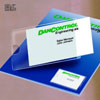Accessories
- Operation Manual
- Calibration Standard
- AC Adapter (9V, 500mA, center-negative)
- Carrying Case
- Serial Interface Cable (Optional)
- Cable Harness (Optional)
Features / Measurements
DENSITY
Densitometers do not actually measure ink thickness, but rather measure reflected light. A logarithmic equation is used to calculate density from the light absorbed by the surface. To calculate the absorbed light on a surface, the difference between the light reflected back from the surface and the light supplied by the densitometer is used.
Densitometers calculate density by using this equation:
Density Equation = log10 1/R, where R= % Reflection
| % Reflectance |
DENSITY |
| 100% |
0.0D |
| 10% |
1.0D |
| 1% |
2.0D |
| 0.1% |
3.0D |
| 0.01% |
4.0D |
| 0.001% |
5.0D |
| 0.0001% |
6.0D |
As you can see the equation is logarithmic, which converts into the values shown on Table 1. To explain the Table further, it can be understood as a density of 1.00 is reflecting 10% of the light.
Your density reading is a guide to keeping your ink level monitored and consistent. In doing this throughout your press run you can detect any changes that could alter your print quality and allow to provide quality control over maximizing the use of your inks.
Below, are some typical wet ink densities, to follow as guidelines.
| |
BLACK |
CYAN |
MAGENTA |
YELLOW |
| SHEET-FED, OFFSET |
1.70 D |
1.40 D |
1.50 D |
1.10 D |
| WEB-OFFSET, Magazine |
1.55 D |
1.30 D |
1.40 D |
1.00 D |
| NON-HEATSET WEB, Newspaper |
1.05 D |
0.90 D |
0.90 D |
0.85 D |
Table 2: GATF-Measurements were made using a Status-T densitometer, and the density of the paper was included in the measurement.
Most densitometers give you the option to include or not include the density of your substrate into your reading. If you chose to include the measured density of the substrate or base along with the ink sample, this is known as Absolute Density. If you subtract the density of the substrate from the density of the ink sample, this is known as Relative Density.
DENSITY DIFFERENCE
Density Difference allows you to establish a reference density and compare this to a sample density. Say you choose your reference color and it reads Yellow 1.05D. Now, take a reading of your sample color- say it reads Yellow 1.02D. The densitometer will subtract your reference color from your sample to show the difference between the two densities. In this example, your Sample yellow deviates (-0.03D) from your Reference yellow.
Many times the naked eye is not enough. Two colors may appear to be identical when in reality they are not. You may notice changes in your image, yet you feel your density value has remained constant. The density difference function helps aid in these situations.
DOT AREA
Keeping your dot size consistent in printing is very important. If your dot size changes throughout your press run it can have drastic effect on your image. For this reason, most densitometers provide you with dot area. This is an estimated percentage of the dot size on your print.
Changes in dot size can be the most common problem to incorrect color. In using the dot area function, the densitometer allows you to keep a monitor on your dot size throughout your press run so you can keep your color consistent.
DOT GAIN
Dot gain occurs when wet ink comes in contact with paper. As the ink dots are applied to the paper, the wet ink spreads, causing the dots to increase in size and appear darker, the size of the dot changes. This occurs in any printing job, however, the goal is to keep your dot gain consistent. For example, if the original had a dot area of 50% on the film and the resulting printed dot area was 68%, the dot gain would be 18%. Generally, the higher the screen ruling, the higher the dot gain. The densitometer will compute percent dot area and then the coverage of the printed image, thus comparing these readings to display dot gain.
As with dot area, almost any job allows for dot gain, however, if this number fluctuates or changes in any way during your press run, it can cause colors to change.
The table below shows some typical Dot Gain values for three common printing conditions.
| |
BLACK |
CYAN |
MAGENTA |
YELLOW |
SCREEN RULING |
| SHEET-FED, OFFSET |
40% |
36% |
36% |
30% |
150 |
| WEB-OFFSET, Magazine |
36% |
31% |
31% |
28% |
133 |
| NON-HEATSET WEB, Newspaper |
24% |
22% |
22% |
18% |
85 |
Table: GATF-Measurements were made using a Status-T densitometer, and dot gain was calculated using the Murray-Davies Equation, measures at the 50% film dot area.
PRINT CONTRAST
The better your image can hold shadow detail the better your print contrast will be. When you have high print contrast values your image will appear richer and more brilliant. If your Print Contrast values are low your image will appear neutral. You want your print to have as high a contrast as possible, however, if you increase the ink too much, it can become blocked up and you lose your dots. The Print Contrast function, provides you with your contrast values as they increase, and then the point at which it begins to decrease, this allows you to reach your optimal density for optimal contrast level.
By using the print contrast function, you will be able to achieve the maximum contrast from your image.
The table below shows some typical Print Contrast values for three common printing conditions.
| |
BLACK |
CYAN |
MAGENTA |
YELLOW |
SCREEN RULING |
| SHEET-FED, OFFSET |
40% |
36% |
36% |
30% |
150 |
| WEB-OFFSET, Magazine |
36% |
31% |
31% |
28% |
133 |
| NON-HEATSET WEB, Newspaper |
24% |
22% |
22% |
18% |
85 |
Table: GATF-Measurements were made at the 75% dot area using a Status-T densitometer.
DOT ANALYSIS
Dot analysis allows the user to record the dot gain characteristics of a printing system. The dot gain measurements are recorded on a 10% graduated scale. A corresponding graph is generated to show a visual representation. The data can be saved on a file for future reference.
Product Specifications
Measuring Geometry: 0°/45° (ANSI PH2.17, ISO 5/4, DIN 16536)
Filter Response Status: Visual (ISO 5/3)
Repeatability: ±0.01D (1%)
Measuring Range: Density 0.00D - 2.50D, Dot Area 0% - 100%
Accuracy: ±0.02D(2%)
Light Source: Halogen Lamp, Approx. 2856°K
Aperture Diameter: 3.0mm (1.7mm optional)
Detector: GaAsP Photodiode
Display: 128 x 64 Dot Graphic LCD
Power Supply: Ni-Cad (4.8V), 800mAh
Recharge Time: Approximately 1.5 hours
Measurements per Charge: Approximately 4,000 (Internal Testing)
Warm Up Time: None
Measuring Time: Approximately 1 second
Operating Temp. Range: 41°F ~ 104°F (5°C ~ 40°C)
Polarization Filter: (Optional)
Security User Code: (Optional)
Dimensions: 2 3/4" W x 2" H x 8 1/4" L (72mm x 50mm x 210mm)
Weight: 1.2 lbs. (with batteries) (530 g)
Computer Output: Configurable RS-232C Serial Interface
Comes standard with a US 2-Pin flat plug.
Also available with a Euro 2-pin round plug or a British 3-pin plug.
E-mail for information and a quote.
If ordering a NiCd Battery Pack please include the below information to verify correct battery is being ordered.
- E-mail serial number of existing densitometer, or
- E-mail part number from existing battery pack, or if it shows R1, R2, or R3, or
- E-mail a picture of existing battery connector
- Models: EQP-IHR700, EQP-IHB3, EQP-IHB5, EQP-IHB7 & EQP-IHC5















